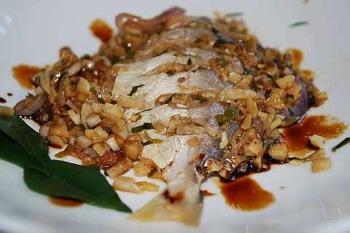Recipe Description
Dongpo rou is named after Su Dong Po, a famous Chinese poet who lived during the Song Dynasty. This recipe is 1,000 years in the making and has made his name, and the Hangzhou province from whence he came, well known all over the world.
I can’t remember the first time I had Dongpo rou because many places have tried to pass off their own versions of the dish, which invariably made it very indistinctive. But the one time I had a well-balanced flavourful Dongpo rou was at an old family restaurant in Kepong. I could still remember how well the meat melded with the fat that it was not stringy. And the fat has been so well rendered out that it wasn’t oily at all. Just before serving, the owners flash fried the cut up cubes so that the outer surface had a slight crispiness. It was heaven in my mouth.
I’ve tried to replicate the memory of this experience and this recipe is the closest I’ve found. It only contains five seasonings but don’t underestimate the impact of the simplicity of ingredients.
Try to get a slab of pork belly that has even layers of fat and meat. The total height of the slab should not exceed 4 cm. The pork also should be cut into cubes no more than 4cm so that it can braise evenly. And not too small so they can be tied properly and not fall apart in the braising liquid.
I managed to get Bentong ginger during the shoot but any old ginger will do. Save the ginger slices after the braising, which I did because I love candied ginger.
You may substitute regular sugar with the rock sugar, but it is recommended because it gives a cleaner taste to the dish.
And makes sure you use premium light soy sauce, which is fragrant without the pungency of regular soy sauce. It is less salty but there’s sufficient amount there to not need additional salt. And please do not add thick dark soy sauce because the caramel and pungency will kill the subtle flavours of the seasonings. I did that once and I regretted it because it tasted like pork stew, not Dongpo pork.
The first time I made Dongpo rou had taken me three hours of braising in a cast iron pot. Now with a pressure cooker, the time is reduced to one hour. However, because the steam does not escape in the pressurised chamber, there tends to be a lot of liquid in the pot. An additional 30 minutes of simmering will reduce the gravy to the right consistency.
Hope you enjoy.
Recipe Ingredient
- 1500 g pork belly
- 400 g scallions, cut to 4cm length
- 300 g ginger, sliced
- 500 ml water
- 70 g rock sugar
- 150 ml premium soy sauce
- 250 ml Shaoxing wine
Instructions
- Cut pork into 4cm cubes. Heat up the wok, put the pork skin side down to sear until it becomes slightly brown.
- Blanch pork in a pot of hot water for five minutes.
- Scatter scallions at the bottom of pot to form a thick even layer. Lay ginger slices evenly over the spring onion.
- Tie the pork cubes with kitchen string.
- Arrange the pork cubes with skin down on top of scallions.
- Add all remaining ingredients into the pot.
- Bring it to a boil with the lid on. When the liquid comes to a boil, reduce the heat and simmer for 90 minutes without stirring. Alternatively braise in pressure cooker for 30 minutes.
- Depressurise and flip the pork pieces skin-side up in the pot. Cover and simmer for another 90 minutes, or braise in pressure cooker another 30 minutes.
- After depressurising, reduce simmering liquid into a thick gravy, about 30 minutes uncovered.
- Transfer pork to a plate. Remove the strings.
- Strain the gravy and skim the fat off the top. Drizzle gravy over pork and serve.









